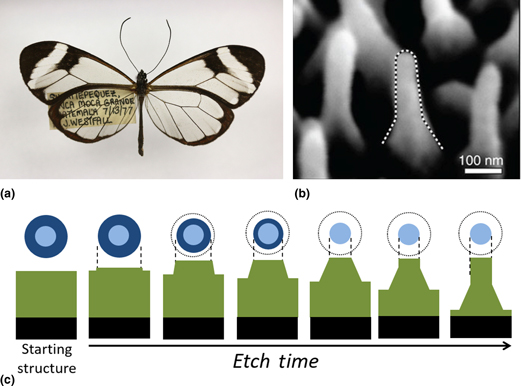Article contents
Biomimetic non-uniform nanostructures reduce broadband reflectivity in transparent substrates
Published online by Cambridge University Press: 08 May 2019
Abstract

The remarkable broadband and omnidirectional anti-reflectivity observed in the glasswing butterfly arises from the random array of nanopillars present on their wings. In the present study, analogous structures have been replicated on transparent substrates using a scalable, low-cost method that exploits surface dewetting of silver thin films on silica substrates to form an etch mask. Directional etching was applied with high selectivity between Ag and SiO2 using CHF3, allowing large aspect ratios to be achieved with 20 min etches. Single-sided nanostructuring of glass by this method improved the transmission of light by 2–8% for viewing angles of 25°, 45°, and 65°.
Information
- Type
- Research Letters
- Information
- Copyright
- Copyright © Materials Research Society 2019
References
1.Macleod, H.A.: Thin-Film Optical Filters, 4th ed. (Taylor & Francis, Boca Raton, FL, 2010).Google Scholar
2.Cai, J. and Qi, L.: Recent advances in antireflective surfaces based on nanostructure arrays. Mater. Horiz. 2, 37 (2015).Google Scholar
3.Siddique, R.H., Gomard, G., and Holscher, H.: The role of random nanostructures for the omnidirectional anti-reflection properties of the glasswing butterfly. Nat. Commun. 6, 6909 (2015).Google Scholar
5.Guenther, K.H.: Physical and chemical aspects in the application of thin films on optical elements. Appl. Opt. 23, 3612 (1984).Google Scholar
6.Raut, H.K., Ganesh, V.A., Nair, A.S., and Ramakrishna, S.: Anti-reflective coatings: a critical, in-depth review. Energy Environ. Sci. 4, 3779 (2011).Google Scholar
7.Yoldas, B.E.: Investigations of porous oxides as an antireflective coating for glass surfaces. Appl. Opt. 19, 1425 (1980).Google Scholar
8.Bernhard, C.G., Miller, W.H., and Moller, A.R.: The insect corneal nipple array. A biological, broad-band impedance transformer that acts as a antireflection coating. Acta Physiol. Scand. 63, Suppl 2431, 1–79 (1965).Google Scholar
9.Clapham, P.B. and Hutley, M.C.: Reduction of lens reflexion by the ‘Moth Eye’ principle. Nature 244, 281–282 (1973).Google Scholar
10.Yoshida, A., Motoyama, M., Kosaku, A., and Miyamoto, K.: Nanoprotuberance array in the transparent wing of a hawkmoth, Cephonodes hylas. Zool. Sci. 13, 525 (1996).Google Scholar
11.Morikawa, J., Ryu, M., Seniutunas, G., Balcytis, A., Maximova, K., Wang, X., Zamengo, M., Ivanova, E., and Juodkazis, S.: Nanostructured antireflective and thermoisolative cicada wings. Langmuir 32, 4698 (2016).Google Scholar
12.Craighead, H.G., Howard, R.E., Sweeney, J.E., and Tennant, D.M.: Textured surfaces: optical storage and other applications. J. Vacuum Sci. Technol. 20, 316 (1982).Google Scholar
13.Halir, R., Bock, P.J., Cheben, P., Ortega-Monux, A., Alonso-Ramos, C., Schmid, J.H., Lapointe, J., Xu, D., Wanguemert-Perez, J.G., Molina-Fernandez, I., and Janz, S.: Waveguide sub-wavelength structures: a review of principles and applications. Laser Photonics Rev. 9, 25 (2015).Google Scholar
14.Siddique, R.H., Donie, Y.J., Gomard, G., Yalamanchili, S., Merdzhanova, T., Lemmer, U., and Hölscher, H.: Bioinspired phase-separated disordered nanostructures for thin photovoltaic absorbers. Sci. Adv. 3, 1700232 (2017).Google Scholar
15.Huang, Y., Chattopadhyay, S., Jen, Y., Peng, C., Liu, T., Hsu, Y., Pan, C., LO, H., Hsu, C., Chang, Y., Lee, C., Chen, K., and Chen, L.: Improved broadband and quasi-omnidirectional anti-reflection properties with biomimetic silicon nanostructures. Nat. Nanotechnol. 2, 770 (2007).Google Scholar
16.Chan, L., DeCuir, E.A. Jr., Fu, R., Morse, D.E., and Gordon, M.J.: Biomimetic nanostructures in ZnS and ZnSe provide broadband anti-reflectivity. J. Optics 19, 11 (2017).Google Scholar
17.Huang, Y., Jen, Y., Chen, L., Chen, K., and Chattopadhyay, S.: Design for approaching cicada-wing reflectance in low- and high-index biomimetic nanostructures. ACS Nano 9, 301 (2015).Google Scholar
18.Chen, Y.C., Huang, Z.S., and Yang, H.: Cicada-wing-inspired self-cleaning antireflection coatings on polymer substrates. ACS Appl. Mater. Interfaces 7, 25495 (2015).Google Scholar
19.Zhang, G., Zhang, J., Xie, G., Liu, Z., and Shao, H.: Cicada wings: a stamp from nature for nanoimprint lithography. Small 2, 1440 (2006).Google Scholar
20.Xie, G., Zhang, G., Lin, F., Zhang, J., Liu, Z., and Mu, S.: The fabrication of subwavelength anti-reflective nanostructures using a bio-template. Nanotechnology 19, 095605 (2008).Google Scholar
21.Sun, J., Wang, X., Wu, J., Jiang, C., Shen, J., Cooper, M.A., Zheng, X., Liu, Y., Yang, Z., and Wu, D.: Biomimetic moth-eye nanofabrication: enhanced antireflection with superior self-cleaning characteristic. Sci. Rep. 8, 5438 (2018).Google Scholar
22.Binetti, V.R., Schiffman, J.D., Leaffer, O.D., Spanier, J.E., and Schauer, C.L.: The natural transparency and piezoelectric response of the Greta oto butterfly wing. Integr. Biol. (Camb.) 1, 324 (2009).Google Scholar
23.Thompson, C.: Solid-state dewetting of thin films. Annu. Rev. Mater. Res. 42, 399 (2012).Google Scholar
24.Craighead, H.G., Howard, R.E., Sweeney, J.E., and Tennant, D.M.: Textured surfaces: optical storage and other applications. J. Vac. Sci. Technol. 20, 316 (1982).Google Scholar
25.Jorgensen, G.J., Brunold, S., Koehl, M., Nostell, P., Oversloot, H., and Roos, A.: Durability testing of antireflection coatings for solar applications, in SPIE Int. Symp. on Optical Science, Engineering, and Instrumentation, edited by Lampert, C.M. and Granqvist, C. (International Society for Optics and Photonics, 3789, Denver, CO, 1999), pp. 66–76.Google Scholar
26.Gil-Alana, L.A., Aye, G.C., and Gupta, R.: Trends and cycles in historical gold and silver prices. J. Int. Money Finance 58, 98 (2015).Google Scholar
27.Madocks, J. and Seaman, W.: Anti-reflective coatings by plasma enhanced chemical vapor deposition for large area applications, in Society of Vacuum Coaters 54th Annual Technical Conference Proceedings, edited by McClure, D. (Society of Vacuum Coaters, Chicago, IL, 2011), pp. 229–233.Google Scholar
- 4
- Cited by

